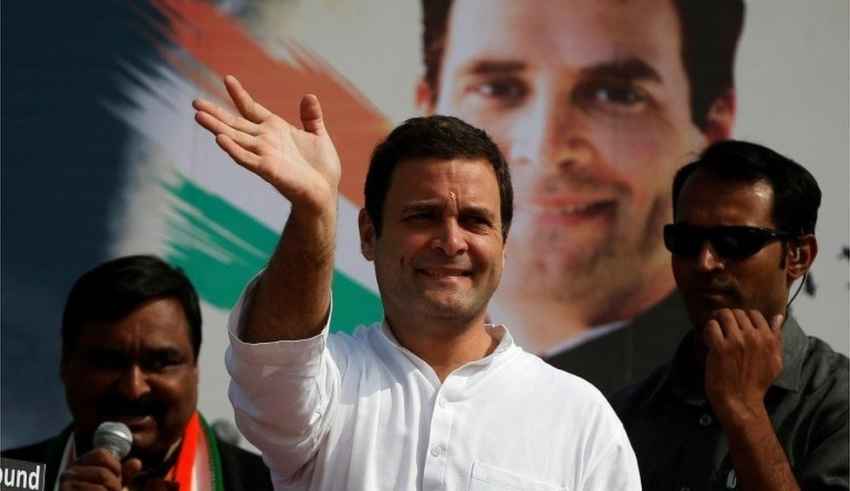
India’s respected Congress Party elects a new chairman. The new leader will not come from the Gandhi clan. But it is questionable whether this will bring about the new beginning that has been longed for.
Rahul Gandhi is trying to attract attention with a long march through India. In five months, the 52-year-old opposition politician from the Congress Party wants to cover 3570 kilometers from south to north – and cross twelve states in the process. The campaign, which was initially ridiculed, is proving to be surprisingly successful. Since Gandhi set off in September, it has produced effective images of the politician talking to the people. One shot of him tying the shoelaces of his 75-year-old mother Sonia Gandhi on the way became went viral on social media.
Reviving memories of the protest marches from Indian freedom hero Mohandas “Mahatma” Gandhi is intentional. The icon of India’s independence movement, who died in 1948, is not related to the marching opposition politician, despite sharing the same name. Rather, Rahul Gandhi is a great-grandson of India’s first prime minister, Jawaharlal Nehru, who together with “Mahatma” Gandhi once led the Indian National Congress. Since India achieved independence in 1947, the Nehru-Gandhi clan had dominated politics, or at least the Congress Party, for decades. Sonia Gandhi, the Italian-born widow of former Prime Minister Rajiv Gandhi, who was assassinated in 1991, has headed the party since 1998, with an interruption of two years.
Former ruling party powerless against Modi
But India’s Grand Old Party seems powerless against the power, populism and electoral machinery of incumbent Prime Minister Narendra Modi and his nationalist Bharatiya Janata Party (BJP). It has lost dozens of regional elections in recent years. The party still forms the government in only two of the 29 states. In each of the last two general elections in 2019, it received just over 19 percent of the vote under top candidate Rahul Gandhi. With an eye on the upcoming regional elections in Modi’s home state of Gujarat and in Madhya Pradesh, both ruled by the BJP, it is trying to get back on its feet. In 2024, Indians will also vote again at the national level.
The march of Nehru’s great-grandson Rahul Gandhi is only one part of the renewal strategy. The other lies in Monday’s election of a new party president. For the first time in about a quarter century, the post will not be held by a member of the Gandhi family. Sonia Gandhi is not running again. Her son Rahul, who had held it for a short time between 2017 and 2019, is also not standing for election despite his high-profile campaign. Now vying for the post are intellectual and former diplomat Shashi Tharoor and veteran Congress politician Mallikarjun Kharge, who had led the opposition faction in the upper house until October.
The results of the election are not expected until Wednesday. Multiple former minister Kharge, who is considered a Gandhi loyalist, is seen as having the best chance. Although the family has not publicly backed a candidate, no one doubts it favors him. At 80, he is part of the old guard. New impetus is not to be expected from him. “Kharge will make no difference to the Congress”, comments The Hindu newspaper.
The Ghandis will maintain their influence
If the 66-year-old Tharoor is elected after all, it would be more of a new beginning. Tharoor was once one of the deputies of then UN Secretary-General Kofi Annan and came in second behind Ban Ki-moon in the election to succeed him. He is the author of several books on Hinduism, nationalism and the history of India. Tharoor sees himself as a reform candidate who appeals to the youth, and is considered ambitious, capable and dynamic. “He is what the Congress needs but unfortunately will not get”, predicts The Hindu.
The new leader must lead the party out of the valley of tears. Observers, however, see not only Modi’s strength but also the Congress party’s weakness as causal for its failures. They say it is unclear what the party still stands for politically, other than opposition to Modi and a secular state. Some regional parties are now more successful in challenging the ruling party below the national level. One weakness of the party is the dominance of the Gandhis. The intertwining of party and family is too close for the necessary personnel renewal. Former prominent members of the Congress Party have even switched to the BJP.
Some therefore see the election as a farce. The next leader will have to counter the impression that he is being remote-controlled by the Gandhis. Hardly anyone expects their influence to end completely. Rahul Gandhi’s long march does not speak for this either. Three prime ministers have so far come from the Nehru-Gandhi clan : in addition to his great-grandfather Jawaharlal Nehru, his grandmother Indira Gandhi and his father Rajiv Gandhi. Mother Sonia Gandhi had led the party to electoral victories, but because of her background she never ran for government office herself.
Rahul Gandhi seemed reluctant to accept his role as future head of government. That has since changed. But according to polls, only nine percent of respondents want him as head of government, compared with more than 50 percent for Modi. His march is now intended to raise his profile once again. He calls the action “Bharat Jodo Yatra” : March for the Unification of India. But it is also intended as a sign of resistance against the sheerly overpowering Modi, whom the Congress Party accuses of pursuing a policy of dividing India along religious lines.
By The European Institute for International Law and International Relations.












